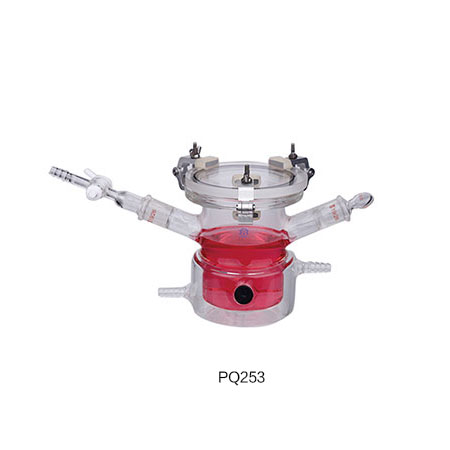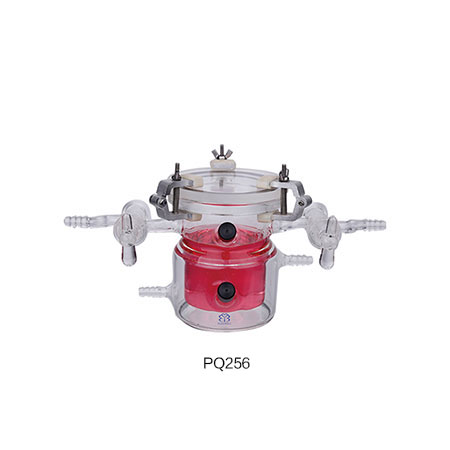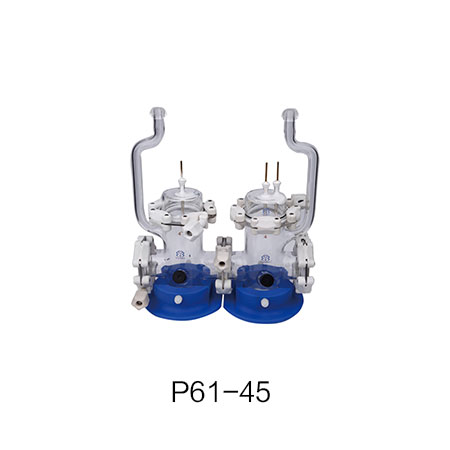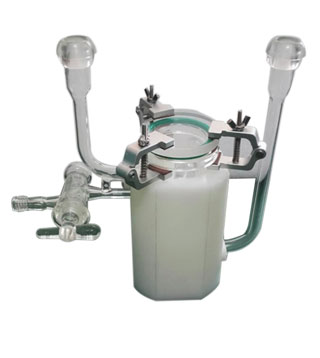The photoreactor is the core component of the photochemical reaction system. Perfectlight company has developed and accumulated various reactor models that are suitable for different types of photochemical reactions. These reactors can meet the diverse requirements of users in terms of light transmission, gas introduction and extraction, vacuum pumping, temperature control, high pressure, high temperature, photogenerated composite energy fields, and photo-thermal reactions.
PQ Series Reactors
The PQ series reactors are top-illuminated photoreactors with quartz flat plate or quartz jacketed windows, made from JGS-2 quartz material. They are suitable for liquid-solid phase photo-degradation reactions and more. These reactors are equipped with sampling ports for manual collection of liquid samples for testing. Depending on requirements, additional features like expansion ports, sampling ports, glass valves, or constant temperature jackets can be added. The expansion port uses a standard grinding mouth that can be connected to compatible accessories. Before starting the experiment, vacuum operations can be performed on the reactor, or materials can be added during the reaction process. The sampling port uses glass outer thread technology to fix the inlet pad, enabling sampling from the sealed reaction system without opening the reactor.
The PQ series reactors offer high gas tightness and are also suitable for photochemical reactions involving gases. To control the reaction atmosphere, it's often necessary to replace the residual volume in the reactor and the gases dissolved in the reaction solution. Hence, these reactors often have gas blowing inlets and outlets.


Photovoltaic Reactor
Research in electrochemistry involves the interconversion of light energy, electrical energy, and chemical energy. By controlling and detecting signals like voltage and current, the conversion processes of these three energies can be rapidly reflected. Consequently, more and more researchers are engaging in this field to study material properties under composite photovoltaic energy fields.
To meet these research needs, Perfectlight has introduced photovoltaic reactors that are highly airtight and easy to connect. These reactors have a main body made of high borosilicate glass material and feature flange connections, O-ring seals, and multi-joint chain clamps for ease of operation. The detachable light window allows for easy cleaning, and the electrodes are fixed using a plug-and-play method. Standard three-electrode systems are available, including ITO/FTO or glass carbon (straight or L-shaped) working electrodes with corresponding electrode fixtures.
Based on their structure, photovoltaic reactors can be categorized as single-chamber reactors and dual-chamber reactors (also known as H-type reactors). The latter have proton exchange membranes fixed in the connecting part of the two chambers, preventing direct mixing of reaction media on both sides and avoiding reverse reactions.


Inner Illumination Reactor
Based on the relative positions of the light source and reactor and whether a plane can be used to spatially separate the two, photoreactors can be classified as inner illumination reactors (also known as built-in reactors) and outer illumination reactors (also known as external reactors). Inner illumination reactors are typically composed of a cold trap and a reactor. The primary function of the cold trap is to reduce the temperature of the lamp and filter out most of the infrared heat. Depending on the material, cold traps are made of quartz glass or high borosilicate glass. Quartz glass traps can also be used for UV photochemical studies in the wavelength range of 200~330 nm. The outside of the cold trap houses the reaction medium and is usually made of high borosilicate glass, serving various application forms.
PLR OTPR-I Online Temperature Measurement Gas-Solid Phase Photocatalytic Reactor
The online temperature measurement gas-solid phase photocatalytic reactor is designed for use with the Labsolar-6A system, enabling photocatalytic photo-thermal coupling of gas-solid phase reactions. With a low heat dissipation design, this reactor is compatible with powders, porous films, thin layer block materials. It uses intense incident light to heat the photosensitive material, allowing real-time online monitoring of the catalyst surface temperature and sampling for gas component analysis during the reaction.
1. Suitable for powders, films, and thin layer block materials;
2. CO₂ gas reduction, gas pollutant degradation, etc.;
3. Efficient passage of reaction gases through the catalyst layer;
4. Online real-time monitoring of catalyst surface temperature (requires on-site infrared thermometer).

On-Site Infrared Thermometer
This instrument can automatically record catalyst surface temperature in real-time. It employs infrared temperature measurement technology, ensuring non-contact temperature measurement accuracy. Automatic recording occurs at 1-second intervals with a temperature accuracy of 0.1°C. Measurement data can be exported via USB.
Custom Reactors
With years of glass instrument design experience and a professional glass processing factory, our company not only offers standard products but also accepts custom orders for specialty products to meet your specific research needs.
Recommended
Solution